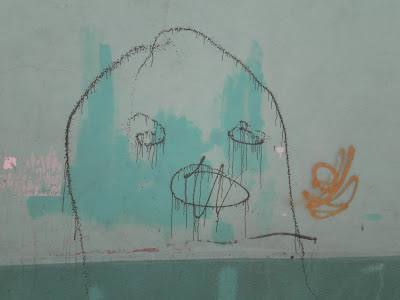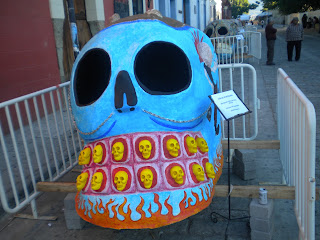Hello friends!!!
I know - it's been a really long time - let's just save us the ensuing awkward conversation/groveling and just jump into my next blog post... OAXACA (Whaaa-HAW-kah).
I'm been so busy that I have neglected to tell you all about my Day of the Dead journey that I made while all you in the United States were celebrating Halloween by getting wasted on candy and dressing in gender-confusing costumes.
I've been a huge fan of Day of the Dead and the whole culture that surrounds it, so going into my study abroad adventure I was
stoked for Day of the Dead. I decided to spend this awesome day in the equally awesome city of Oaxaca, this decision being mostly influenced by the fact that los Poblanos (the people of Puebla) don't really celebrate Day of the Dead, so leaving town was a given. Second, the culture of Oaxaca is friggin' awesome and so are their Day of the Dead festivities.
A few friends and I started off the weekend by going through Oaxaca, desposing of one of our classmates in the city while we continued for the coast... Which was
Puerto Escondido. The trip was vale la pena (worth the pain), even though it was about a 5 hour bus ride into Oaxaca and another 10 HOURS to Puerto Escondido. And to make matters worse, at about 2 hours out of Oaxaca on our overnight bus ride, one of fellow passengers suffered a something I can only call a 'medical episode'. To be honest, I don't really know what happened to this poor woman, but the paramedics had to be called and everyone on the bus had to wait for their arrival --- for a full two hours.
Also, we happened to stop at a military checkpoint, and at first when I had NO idea what was going on, I thought that the solidiers were going to comandeer our bus when they starting boarding... HAAA. Thankfully, it was only a medical problem and we made it safely to P.E.
I had not been to the beach for over 2 years, so once I laid eyes upon the pristine waters and the desolate shores I got excited... Really excited. I literally wanted to rip my shirt off and sprint into the water. For our lodging, we stayed in a small hostel outside of the actual town of Puerto Escondido, on a beach known as Zicatela. Temperatures were in the high 80's low 90's the entire time and I think it's the closest I've been to paradise.
The only problem with the beach were the waves, they were almost deadly; one of my friends was knocked down, and cut up her back and legs on some stones in the process. But thankfully she quickly recovered and we all ate at a shwanky restuarant on the beach later that night. All I have to say about the food is... Mmmm.
Besides the beach, I also went on a lagoon tour and spent one night on the town partying it up, including making an appearance at a toga party at one of the larger bars. Unfortunately, I did not dress up, though I did see a lot of bed sheets and bath towels reinvented into Greek wonders. The amount of Europeans at Puerto Escondido was a little strange for me; the toga party had the largest gathering of non-Mexicans I'd seen since I left Vegas in August.
After two days in paradise and a chance encounter with my Swede and German friends from Puebla, we headed back to Oaxaca for the Day of the Dead.
The day before the big day we headed over to Monte Alban, an ancient fortress city that sits on top of one of the many mountains that surround Oaxaca. I had heard about the ancient city a few times before, but I had absolutely no idea at how big it actually was. I was taken aback by its size, it truly amazed me at how much people could achieve before our modern technology.
After the ruins, we spent the remainder of our time in the city proper, enjoying all that Oaxaca had to offer; chocolate, ofrendas, giant skulls, mezcal, food, and more awesome sights as well.
Downtown in the zócalo, the city had set up some sand formations to celebrate Day of the Dead.
On Halloween night, I was fortunate enough to watch a legit Mexican folk dance show just outside of downtown area in the courtyard of a colonial church. The steps were decorated with flowers and candles and numerous altars, it was a sight to behold.
The last dance of the night was the traditional dance of the devils, in which the dancers wore diablo masks (and fur pants) while cracking whips. My friend was even beckoned to dance with them (sorry Chels), haha.
The night was unforgetable, and I'm so glad at the opportunity to witness something so off the beaten path and so culturally rich.
BUT THEN IT WAS DAY OF THE DEAD.
For those of you who may not be acquainted with this traditional Mexican holiday, let me get you up to speed really quick...
The traditions of Day of the Dead date back in Mexico to the times before the Spanish arrived and destroyed everything (precolombian), and its a day when Mexicans and other Latin Americans celebrate the lives of those who have passed on. Many believe that it is they day in which the veil between the living world and the underworld is lifted, and the spirits roam amongst us. Due to this, a lot of Mexican will make altars (known as ofrendas) to commemorate their deceased loved ones, but they are also used in a way to summon their spirits as they pass from the spirit world into the real world. Many altars will have the picture of the loved one, and also fragrant foods and flowers to attract them.
Also on this night many of the families visit the graves of their loved ones and lay candles and flowers to beautiful their resting place. Its also a time and place to talk about their loved ones and grieve in a healthy way. I love this concept and wish that United States wasn't so far removed from a subject that affects ALL of us. Death is such a taboo topic in the US, and I think its so healthy to bring it out into the open and even celebrate it.
A few friends and I decided to visit the main cementery in town, which was not only HUGE, but also had a carnival set up outside the walls of the graveyard. Excitement and joy filled the air as mariachi bands and costumed people wandered the graveyard. Parents brought their children, and even the elderly were enjoying themselves.
I can't 'til next year. I'm so going to make my own ofrenda.








































































